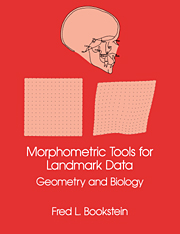7 - Features of shape comparison
Published online by Cambridge University Press: 23 November 2009
Summary
For a data base consisting of Cartesian coordinates of homologous landmarks upon forms not too dissimilar, there is at root only one statistical analysis of shape. The analysis resides in a space of 2 K – 4 dimensions, where K is the number of landmark points involved. For triangles, this space is two-dimensional, like the space in which the data were gathered. For any larger number of landmarks, the space of shape descriptors has higher dimensionality than the physical space of the data. Then diagrams of tensor analysis are necessary to reexpress these findings in terms of vectors distributed over the space in which the data were gathered: K – 2 2-vectors corresponding to the 2 K – 4 dimensions of shape.
But that vector space must not be confused with the real space inside the organism whose growth or evolution led to the images we are comparing. What should be distributed over the organism are processes, not vectors. We began our intellectual journey in Chapter 2 by abstracting the richness of the notion of biological homology into the stark simplicity of a mathematical point-to-point mapping. This seemed like the most direct way of casting our biological understanding of form into a language susceptible to statistical analysis. From these mapping functions we could systematically select discrete samples, the landmark points. Multivariate statistical analysis could be wrestled into a form adequate to deal with these data in a manner drained of all dependence on such nonbiological matters as choice of triangles or of a coordinate system.
We have not yet justified the severity of this abstraction. It can be defended only by appeal to findings it may expedite that answer to questions from the original context of comparative anatomical analysis.
- Type
- Chapter
- Information
- Morphometric Tools for Landmark DataGeometry and Biology, pp. 256 - 357Publisher: Cambridge University PressPrint publication year: 1992



